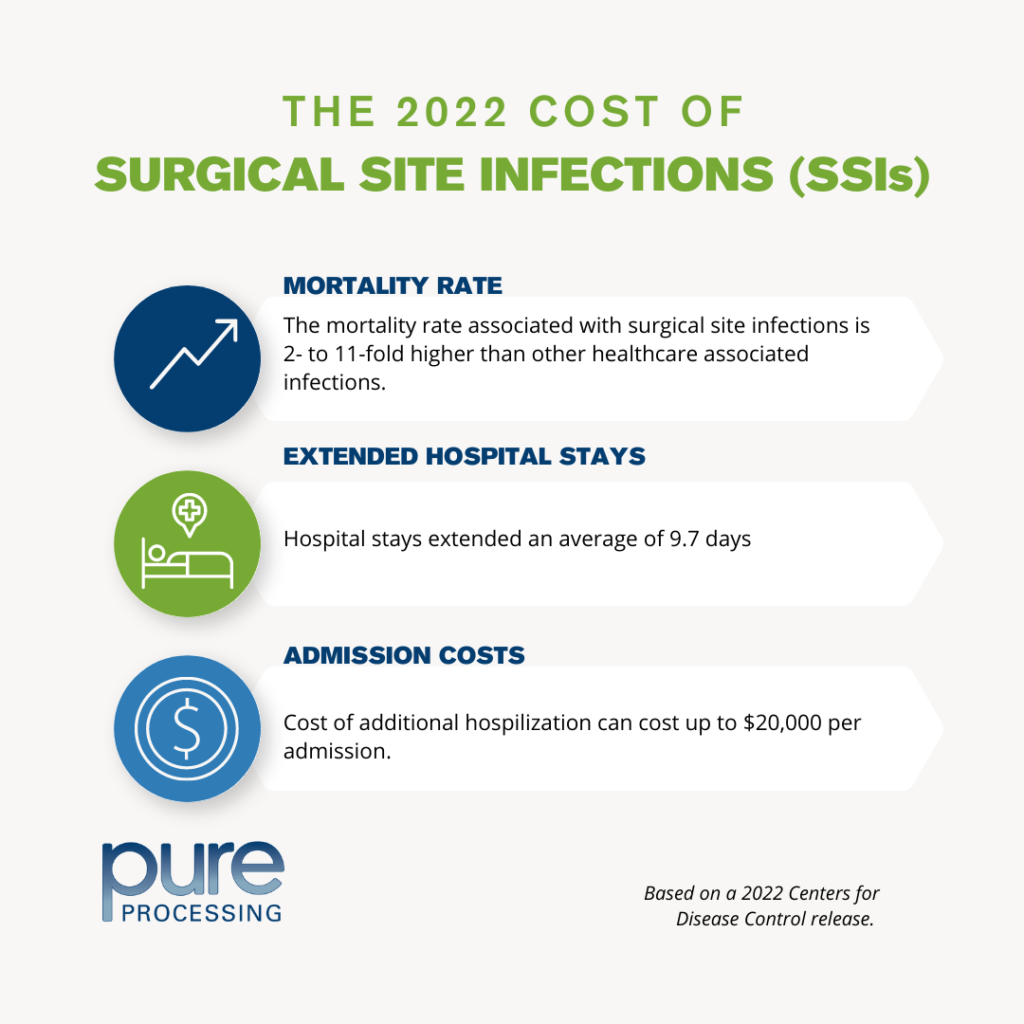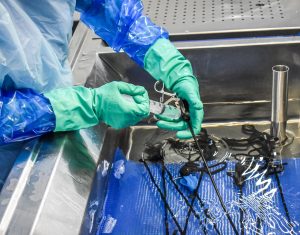
Syringe flushing variability impact to surgical instrument manual cleaning: What’s the risk?
The manual cleaning of reusable and cannulated instruments requires specific steps to meet IFUs, and adequately flushing them before the sterilization process is one of the most critical of these steps.
 The cost of poor manual cleaning outcomes
The cost of poor manual cleaning outcomes
Surgical site infections (SSIs) are a real, significant risk when manual cleaning outcomes aren’t properly followed. In a January 2022 report by the Centers for Disease Control (CDC), SSI’s are 2- to 11-fold higher in their risk of mortality over other healthcare associated infections (HAI’s), extend hospital stays for patients up to 9.7 days, with a cost of hospitalization increased by more than $20,000 per admission1,2,3 . These figures alone cannot include or quantify the pain and difficulty of a loved one suffering from an SSI, and the significant toll on the patients and their families.
Manual cleaning is the foundation to all effective sterilization outcomes. Many reprocessing departments continue to flush instruments with syringes for manual cleaning. For departments still using this method for flushing, it’s important to fully understand how your prescribed methods for meeting IFUs can positively or negatively impact outcomes. Syringes, for example, have a hidden weakness beyond the control of your staff: variability of outcomes.
We can all agree variability is something to be avoided at all costs in any reprocessing department. Consistent flushing and cleaning must occur on instruments with channels where bioburden can lodge and escape the cleaning process. That same bioburden can later break free with potential to infect the next patient if it is not completely removed prior to sterilization. That means standards were not met, and a patient’s outcomes could be negatively impacted. No department wants that.
Some may argue that syringes are just easier to use when flushing. Syringes may appear to shorten flushing time, and they don’t come with own set of IFUs. At first glance they truly do seem like a viable option. So, what exactly makes them so risky?
Technicians and nurses cannot flush the same each time
Technicians and nurses are human beings who may plan to perform consistently. But they are not robots calibrated to operate in exactly the same way during set tasks. Some days may be busier than others and technicians feel rushed to keep up. Or there may be other distractions in the department or from the OR. And sometimes people are simply preoccupied with the demands of their day. There is simply no way a technician can perform the exact same flushing process day to day. Steps can be skipped or inadvertently forgotten.
The bottom line is that no technician or nurse will flush a device with the same pressure and volume every single time. That means variability becomes a factor with each processed instrument.
Syringes are not calibrated for performance
While every technician or nurse strives to meet standards and IFUs, it’s a fact that no two people will flush an instrument the same way with syringes. That’s because syringes cannot be calibrated to consistently perform for the user. They are a manual tool without presets for pressure or volume, and that leads to inconsistency. Syringes cannot indicate when manual cleaning and flushing steps are complete or thorough.
syringes. That’s because syringes cannot be calibrated to consistently perform for the user. They are a manual tool without presets for pressure or volume, and that leads to inconsistency. Syringes cannot indicate when manual cleaning and flushing steps are complete or thorough.
Syringes risk repeated performance variability without functions to guide a user or to confirm IFU flushing steps are complete.
Syringes can cause long-term strain and injury
The physical work involved for sterile processing technicians can be difficult. Handling multiple devices per day, lifting heavy instruments and trays, pushing carts and more already make it a physically demanding role. Add to that the repetition of these tasks day over day, and the risk for potential, long-term injury becomes compounded.
Those deceptive syringes mask an insidious impact to the technicians themselves. It may seem simple to draw and push a syringe multiple times to flush a surgical instrument. But try it for days. Weeks. Months and years. All that strain over time can contribute to ergonomic injuries to wrists and hands. Ergonomic injuries to sterile processing staff can have far reaching impacts, starting with employee injury, workman’s compensation, reduced department turnaround time and productivity, and even staff satisfaction. Are those simple, “easy-to-use” syringes worth it?
It’s time to eliminate the risk of SPD flushing variability
Lessen the risk of variability in your sterile processing department with one simple change: Swap out the syringes. Your department is a key participant in patient safety and outcomes. There would be no clean surgical instruments without you. To that end, all your practices, processes, and trained staff must be at their best. Investigate syringe flushing alternatives that can best support all of your initiatives and take care of your team.
Learn more about the FlexiPump Independent Flushing System to automatically flush internal instrument channels, free up technician time to perform additional tasks, and avoid the repetitive motion pain and injury associated with syringe flushing.
You can also access a free, 1 CE credit by watching our related Royal Flush: Your Winning Hand for Pre-Cleaning Protocol CE program, where we expand on this topic in more detail, and provide you with tools to make changes in your department.
Works Cited
- Ban, K.A., “American College of Surgeons and Surgical Infection Society: Surgical Site Infection Guidelines, 2016 Update”. Journal of the American College of Surgeons, 224(1): (2017), 59-74.
- Zimlichman, E., et al., “Health Care-Associated Infections. A Meta-analysis of Costs and Financial Impact on the US Health Care System”. JAMA Intern Med, 173(22): (2013): 2039-46.
- “Surgical Site Infection Event (SSI).” Centers for Disease Control, CDC, Jan. 2022, https://www.google.com/url?sa=t&rct=j&q=&esrc=s&source=web&cd=&cad=rja&uact=8&ved=2ahUKEwiHkoTMt9r3AhV9g3IEHciCAE8QFnoECAkQAQ&url=https%3A%2F%2Fwww.cdc.gov%2Fnhsn%2Fpdfs%2Fpscmanual%2F9pscssicurrent.pdf&usg=AOvVaw1pfxZuFL-VI2tlEfXGHiDP.
Have a problem you’d like help solving? Let us know!



